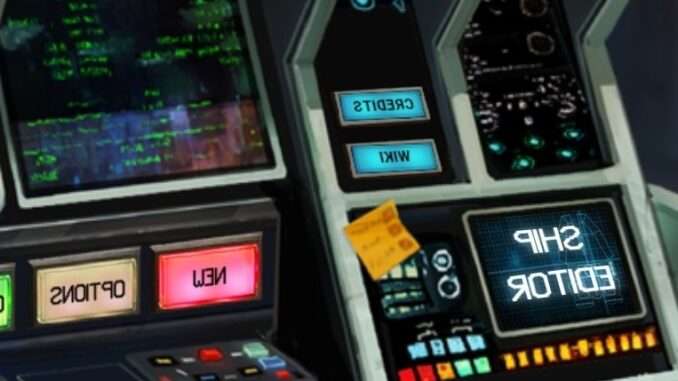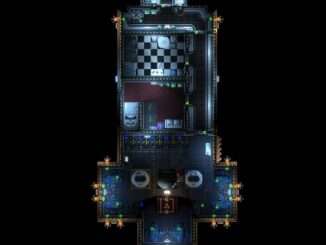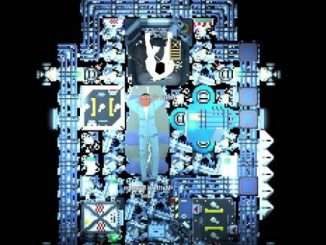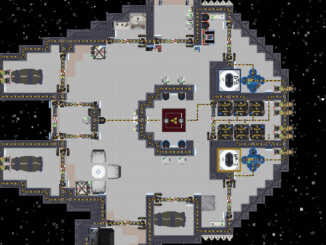
A Quick Reference Guide to all the ships in the game. The purpose of this guide is a quick reference to help identify ships in the boneyard. Once you’ve found your ship, you can pop it open in the editor and test your custom builds.
Small Craft
Inspection Pod
A small craft designed for close inspection work of stations and larger ships. Seats one, and not comfortably.

Katydid
One of the smallest possible spacecraft with an airlock and environmental system, the Katydid is built with MSS parts to cut down even further on weight. The final design was made even smaller when a clever engineer realized that the life support and RCS intake regulator could share a single O2 canister.

SalvagePodSmall
One of a series of small tugs built by Ryokka on contract with Ayotimiwa. Vessels in the Ryokka TU line are ubiquitous and sought after in the OKLG Boneyard given their efficiency for solo spacers and relatively favorable mortgage rates. It’s rumored that the corporation has dozens more factory fresh TU models mothballed in a secret hangar as a strategy to create artificial scarcity.

SCI
A Testudo-manufactured, standard-sized shipping container often stacked on super large cargo liners. Intermodals are often shunted off by small tugs on ballistic trajectories across The System, with the expectation of being caught at their destination by a second tugboat. It means a single small set of tugs can move thousands of tonnes more cargo than a freighter, but the delivery time is in the region of weeks to months rather than hours to days.

SCI Retrofit
A standard cargo container retrofitted with the bare minimum kit necessary to navigate from one point in space to another. An EVA suit is recommended in the event the origin or destination lacks air, or the trip is longer than 15 minutes. Basically a death trap. But cheap!

UtilityPod
The Testudo Melody shares some similarities with the Ryokka TU-77a salvage pod, but with batteries, canisters, intake regulators and RCS thrusters all on the outside. It’s a more capable ship than the ubiquitous Ryokka model, but more difficult to maintain, especially without an EVA suit.

SalvagePodTest
A relic from 2038, the Lilliput was built by Testudo before the colony rush as a ferry between the Earth-side space elevators and Luna. It would look more at home in a museum than in flight. It’s very possible this ship was put into consumer circulation by mistake.

SalvagePodSmall
One of a series of small tugs built by Ryokka on contract with Ayotimiwa. Vessels in the Ryokka TU line are ubiquitous and sought after in the OKLG Boneyard given their efficiency for solo spacers and relatively favorable mortgage rates. It’s rumored that the corporation has dozens more factory fresh TU models mothballed in a secret hangar as a strategy to create artificial scarcity.

Medium Craft
Coffin
A custom racer scratch built for illegal RCS circuit rallies. Maximized for speed and maneuverability, so all systems not relevant to these ends have been cut, including life-support. About as safe as the name implies.

Whistler Hot-Rod
A custom, high-end RCS racer with coveted “orange way” interiors. Not much room, but plenty of vroom.

ShuttleSmall
A small shuttlecraft designed for ferrying between structures and ships in local space. Built to accommodate either a small cabin, quad jump seats, or cargo space, depending on the model.

ShuttleSmallCargo
A small shuttlecraft designed for ferrying between structures and ships in local space. Built to accommodate either a small cabin, quad jump seats, or cargo space, depending on the model.

ShuttleSmallSleeper
A small shuttlecraft designed for ferrying between structures and ships in local space. Built to accommodate either a small cabin, quad jump seats, or cargo space, depending on the model.

SalvagePod
One of a series of small salvage ships built by Ryokka on contract with Ayotimiwa. Vessels in the Ryokka TU line are ubiquitous and sought after in the OKLG Boneyard given their efficiency for solo spacers and relatively favorable mortgage rates. It’s rumored that the corporation has dozens more factory fresh TU models mothballed in a secret hangar as a strategy to create artificial scarcity.

TankerPod N2
One of a series of small tugs built by Ryokka on contract with Ayotimiwa, the 66a hauls heavy water. Vessels in the Ryokka TU line are ubiquitous and sought after in the OKLG Boneyard given their efficiency for solo spacers and relatively favorable mortgage rates. It’s rumored that the corporation has dozens more factory fresh TU models mothballed in a secret hangar as a strategy to create artificial scarcity.

TankerPod O2
One of a series of small tugs built by Ryokka on contract with Ayotimiwa, the 66a hauls heavy water. Vessels in the Ryokka TU line are ubiquitous and sought after in the OKLG Boneyard given their efficiency for solo spacers and relatively favorable mortgage rates. It’s rumored that the corporation has dozens more factory fresh TU models mothballed in a secret hangar as a strategy to create artificial scarcity.

TankerPod Unmarked
One of a series of small tugs built by Ryokka on contract with Ayotimiwa, the 66a hauls heavy water. Vessels in the Ryokka TU line are ubiquitous and sought after in the OKLG Boneyard given their efficiency for solo spacers and relatively favorable mortgage rates. It’s rumored that the corporation has dozens more factory fresh TU models mothballed in a secret hangar as a strategy to create artificial scarcity.

Mid-Large Craft
TankerPod D20
One of a series of small tugs built by Ryokka on contract with Ayotimiwa, the 66a hauls heavy water. Vessels in the Ryokka TU line are ubiquitous and sought after in the OKLG Boneyard given their efficiency for solo spacers and relatively favorable mortgage rates. It’s rumored that the corporation has dozens more factory fresh TU models mothballed in a secret hangar as a strategy to create artificial scarcity.

TankerPod He-3
One of a series of small tugs built by Ryokka on contract with Ayotimiwa, the 66a hauls heavy water. Vessels in the Ryokka TU line are ubiquitous and sought after in the OKLG Boneyard given their efficiency for solo spacers and relatively favorable mortgage rates. It’s rumored that the corporation has dozens more factory fresh TU models mothballed in a secret hangar as a strategy to create artificial scarcity.

Royal Flush
One of the rare small ships manufactured by luxury builder Van Hummel, the Royal Flush is used to shuttle VIP passengers between one expensive location and another. The ship lacks a reactor but is extremely nimble on RCS, boasting two wings with six thrusters each and a Miura intake regulator.

SalvagePodEndurance
A salvage pod with bed and wash facilities built for longer duration salvage jobs. Had limited success given that the TU-77a was released shortly after this design. Comes standard with four large batteries.

Myna
A reactor-powered, cabinless courier with a minimal RCS package. Originally developed as an extended-range military interceptor, the Myna’s weapons were stripped after the contract fell through late into negotiations. The housings left behind from the weapons were unceremoniously converted into a bathroom.

Light Tug
A small salvage ship designed for pushing ships and cargo pods around in local space. Comes standard with a tow brace. Packed with additional RCS thrusters and a spiral of intake regulators to create greater thrust than other similar sized tugs.

Argute Rapid Courier
An extremely fast and highly nimble ship boasting a Miura intake regulator and two packages of ten thrusters on each wing. Originally built as a show model to demonstrate the strength of MSS ship frames, this rare build found a niche as a short range courier for time-critical, small-volume deliveries in torch-limited airspace.

Local Ferry
A small passenger ferry that seats half a dozen and is used for short duration travel. Lacks major amenities beyond barebones environmental management. Includes a toilet but you probably don’t want to use it…

Primigenial PY
An extremely fast, lightweight RCS ship with a design and interior layout inspired by Earther sailing vessels. Boasts double Miura Hydra Intake Regulators and an RCS package with two dozen thrusters. A favorite among the elite Martian hobbyist class in West Lake, the Primigenial is nicknamed the “Hangzhou Hangman” because of how many amateur pilots it kills every year.

LB-77a
Nicknamed the “cattle car,” the LB-77a is designed to ferry EVA suited workers to job sites in local space as cheaply as possible. In the OKLG Boneyard it’s not unusual to see dozens of spacers packed onto the vessel, clinging to cargo webbing, half of them mooing as a joke.

Large Craft
Rouncy
A smallish reactor-powered all purpose vessel perfect for a solo spacer. Comes standard with two Miura “Hydra” Intake Regulators. One of Testudo’s most popular designs. Often compared favorably to the Myna, another Testudo design.

Halberd
A reactor powered pleasure craft with a single cabin and twin linked Miura “Hydra” intake regulators. Built as a collaboration with Mobile Space Systems, half the ship has luxury “orange way” interiors, making the Halberd a highly sought after ship for solo spacers.

Medium Ferry
An extremely large, reactor-powered passenger ferry that seats over a dozen. Designed for medium range travel given the lack of cabins, but is often retrofitted for longer hauls. A spacer superstition dictates that passengers are to tip two yuan to a Charon pilot after a successful journey.

Li Bai Gen II Refit
One of the largest mass-manufactured luxury pleasure yachts, the Li Bai was built by Van Hummel under contract from the hospitality corporation Renske International. The ship is used primarily by the uber-wealthy in the Martian system, especially those being ferried between the planet and its orbitals. Divided starkly between crew and client quarters, the ship sleeps nine comfortably and comes standard with a full cherrywood bar.

Tombolo
Despite being manufactured in 2046, the Tombolo Mk. II freighter remains one of the most popular ships in the System. Powered by a fusion reactor and outfitted with four independently pressurized cargo bays with optional external webbing, the Tombolo is about the largest ship an experienced captain could hope to operate comfortably while flying solo.

Heavy Tug 01
A reactor powered cabinless tug with a low end RCS package. Despite being an incredibly efficient design, the TU44-a is regarded as a bit of an ugly duckling given its non-standard layout.

Ibex
This reactor powered long range survey and exploration vessel can house a small crew in relative comfort. Includes two adjacent air tight bays rated for science and engineering. Given the potentially volatile nature of the experiments done on the Ibex, the ship has additional redundancy in the form of two Nav stations in the standard design.

Tombolo 2
Despite being manufactured in 2046, the Tombolo Mk. II freighter remains one of the most popular ships in the System. Powered by a fusion reactor and outfitted with four independently pressurized cargo bays with optional external webbing, the Tombolo is about the largest ship an experienced captain could hope to operate comfortably while flying solo.

CR-53b
An enormous reactor-powered freighter with abundant floor space. Built as an upgrade to the CR-43, the 53b was Ryokka’s first collaboration with Mobile Space Systems, and features a lighter weight frame than its predecessor. Ideal for long-haul travel.

Ocelot
A large, cylindrical, reactor-powered freighter that comes standard with two D2O tanks. The Ocelot gained minor notoriety in 2078 when an unskilled pilot dragged one across the surface of 1036 Ganymed after miscalculating a simple maneuver. Now folks say the ship only has eight lives left.

Massive Craft
Bulk Lifter
No Description Provided

Edelweiss
A large reactor powered freighter with zero frills. Some claim the Edelweiss was a cheaply thrown together imitation of the Ryokka CR-43, built to cash in on the colony rush and pushed into production as soon as Testudo’s executives got their hands on Ryokka’s early design concepts.

Pequod2
One of the only luxury freighters in existence, the Pequod is used primarily as a showfloor for the kind of uber-wealthy client who insists on seeing their cargo loaded and unloaded personally. Reactor powered, sleeps two with room for more if the cargo bays are retrofitted for crew.

02
Built during the colony rush, this enormous reactor-powered freighter has abundant floor space for hauling and two cabins that each comfortably sleep two. Given that the ship was designed to construct and expand structures throughout the System, it is ideal for long-duration travel and hauling.

02Indy
An independent operator refit of the Ryokka CR-43, a colony rush mainstay. This variant sacrifices one sleeping cabin for a medbay, and some cargo area for a rec room. Designed for hauling in comfort over long periods.

Mesa
Perhaps the most iconic freighter in the early Testudo line, the Mesa is essentially eight big boxes and a long corridor. The initial production run began in 2041 but lasted well into the late 2050s. While not produced in the same volume as the Edelweiss due to issues with assembly facilities, the Mesa is widely regarded as the first true freighter of the colony rush.

RF-72m
A product of executive meddling. The RF-72m was initially designed as a large, longer duration construction vessel, able to house work crews for weeks on end. The introduction of the Testudo Mesa during its development pushed Ryokka into contracting Mobile Space Systems to upgrade its cargo capacity with the addition of four large, flimsy external cargo units to market the ship as a freighter. The move was a costly failure, producing a delicate, overpriced and resource-hungry vessel.






Be the first to comment